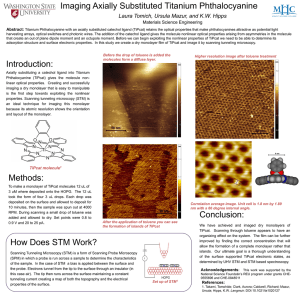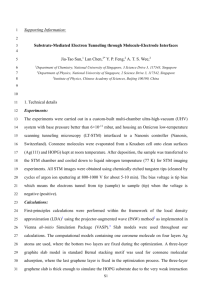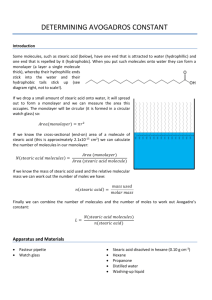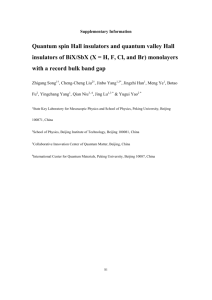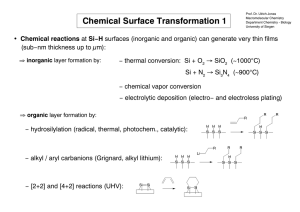Understanding Temperature and Concentration Dependence in the Supramolecular Structure of
advertisement
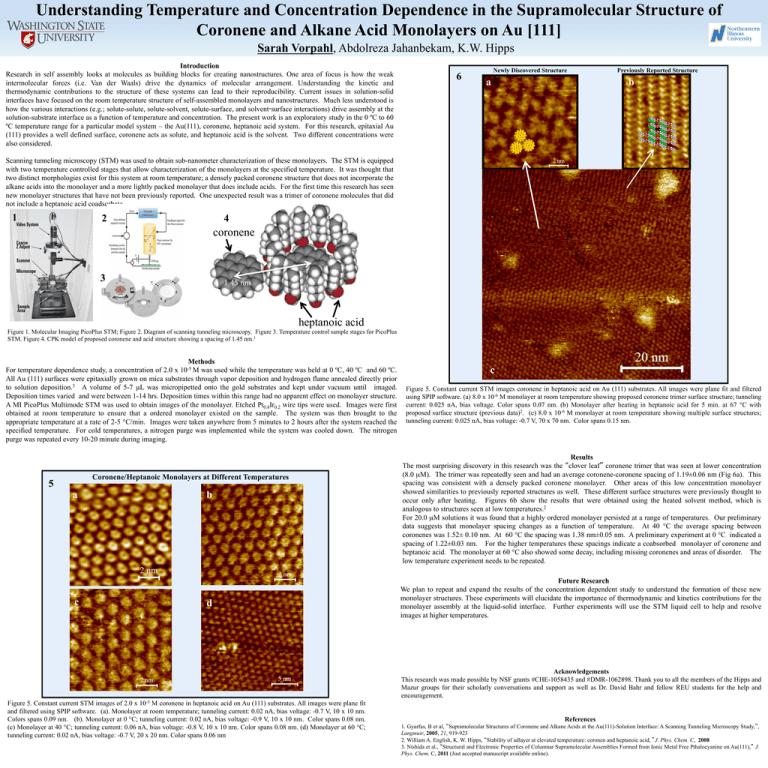
Understanding Temperature and Concentration Dependence in the Supramolecular Structure of Coronene and Alkane Acid Monolayers on Au [111] Sarah Vorpahl, Abdolreza Jahanbekam, K.W. Hipps Introduction Research in self assembly looks at molecules as building blocks for creating nanostructures. One area of focus is how the weak intermolecular forces (i.e. Van der Waals) drive the dynamics of molecular arrangement. Understanding the kinetic and thermodynamic contributions to the structure of these systems can lead to their reproducibility. Current issues in solution-solid interfaces have focused on the room temperature structure of self-assembled monolayers and nanostructures. Much less understood is how the various interactions (e.g.; solute-solute, solute-solvent, solute-surface, and solvent‑surface interactions) drive assembly at the solution-substrate interface as a function of temperature and concentration. The present work is an exploratory study in the 0 ºC to 60 ºC temperature range for a particular model system – the Au(111), coronene, heptanoic acid system. For this research, epitaxial Au (111) provides a well defined surface, coronene acts as solute, and heptanoic acid is the solvent. Two different concentrations were also considered. 6 Newly Discovered Structure Previously Reported Structure a b Scanning tunneling microscopy (STM) was used to obtain sub-nanometer characterization of these monolayers. The STM is equipped with two temperature controlled stages that allow characterization of the monolayers at the specified temperature. It was thought that two distinct morphologies exist for this system at room temperature; a densely packed coronene structure that does not incorporate the alkane acids into the monolayer and a more lightly packed monolayer that does include acids. For the first time this research has seen new monolayer structures that have not been previously reported. One unexpected result was a trimer of coronene molecules that did not include a heptanoic acid coadsorbate. 1 4 2 coronene 3 1.45 nm 12 heptanoic acid Figure 1. Molecular Imaging PicoPlus STM; Figure 2. Diagram of scanning tunneling microscopy. Figure 3. Temperature control sample stages for PicoPlus STM. Figure 4. CPK model of proposed coronene and acid structure showing a spacing of 1.45 nm.1 Methods For temperature dependence study, a concentration of 2.0 x 10-5 M was used while the temperature was held at 0 ºC, 40 ºC and 60 ºC. All Au (111) surfaces were epitaxially grown on mica substrates through vapor deposition and hydrogen flame annealed directly prior to solution deposition.3 A volume of 5-7 µL was micropipetted onto the gold substrates and kept under vacuum until imaged. Deposition times varied and were between 1-14 hrs. Deposition times within this range had no apparent effect on monolayer structure. A MI PicoPlus Multimode STM was used to obtain images of the monolayer. Etched Pt0.8Ir0.2 wire tips were used. Images were first obtained at room temperature to ensure that a ordered monolayer existed on the sample. The system was then brought to the appropriate temperature at a rate of 2-5 °C/min. Images were taken anywhere from 5 minutes to 2 hours after the system reached the specified temperature. For cold temperatures, a nitrogen purge was implemented while the system was cooled down. The nitrogen purge was repeated every 10-20 minute during imaging. c Figure 5. Constant current STM images coronene in heptanoic acid on Au (111) substrates. All images were plane fit and filtered using SPIP software. (a) 8.0 x 10-6 M monolayer at room temperature showing proposed coronene trimer surface structure; tunneling current: 0.025 nA, bias voltage. Color spans 0.07 nm. (b) Monolayer after heating in heptanoic acid for 5 min. at 67 °C with proposed surface structure (previous data)2. (c) 8.0 x 10-6 M monolayer at room temperature showing multiple surface structures; tunneling current: 0.025 nA, bias voltage: -0.7 V, 70 x 70 nm. Color spans 0.15 nm. c 5 Coronene/Heptanoic Monolayers at Different Temperatures a c b d Results The most surprising discovery in this research was the clover leaf coronene trimer that was seen at lower concentration (8.0 µM). The trimer was repeatedly seen and had an average coronene-coronene spacing of 1.19±0.06 nm (Fig 6a). This spacing was consistent with a densely packed coronene monolayer. Other areas of this low concentration monolayer showed similarities to previously reported structures as well. These different surface structures were previously thought to occur only after heating. Figures 6b show the results that were obtained using the heated solvent method, which is analogous to structures seen at low temperatures.2 For 20.0 µM solutions it was found that a highly ordered monolayer persisted at a range of temperatures. Our preliminary data suggests that monolayer spacing changes as a function of temperature. At 40 °C the average spacing between coronenes was 1.52± 0.10 nm. At 60 °C the spacing was 1.38 nm±0.05 nm. A preliminary experiment at 0 °C indicated a spacing of 1.22±0.03 nm. For the higher temperatures these spacings indicate a coabsorbed monolayer of coronene and heptanoic acid. The monolayer at 60 °C also showed some decay, including missing coronenes and areas of disorder. The low temperature experiment needs to be repeated. Future Research We plan to repeat and expand the results of the concentration dependent study to understand the formation of these new monolayer structures. These experiments will elucidate the importance of thermodynamic and kinetics contributions for the monolayer assembly at the liquid-solid interface. Further experiments will use the STM liquid cell to help and resolve images at higher temperatures. Acknowledgements This research was made possible by NSF grants #CHE-1058435 and #DMR-1062898. Thank you to all the members of the Hipps and Mazur groups for their scholarly conversations and support as well as Dr. David Bahr and fellow REU students for the help and encouragement. Figure 5. Constant current STM images of 2.0 x 10-5 M coronene in heptanoic acid on Au (111) substrates. All images were plane fit and filtered using SPIP software. (a). Monolayer at room temperature; tunneling current: 0.02 nA, bias voltage: -0.7 V, 10 x 10 nm. Colors spans 0.09 nm. (b). Monolayer at 0 °C; tunneling current: 0.02 nA, bias voltage: -0.9 V, 10 x 10 nm. Color spans 0.08 nm. (c) Monolayer at 40 °C; tunneling current: 0.06 nA, bias voltage: -0.8 V, 10 x 10 nm. Color spans 0.08 nm. (d) Monolayer at 60 °C; tunneling current: 0.02 nA, bias voltage: -0.7 V, 20 x 20 nm. Color spans 0.06 nm References 1. Gyarfas, B et al, Supramolecular Structures of Coronene and Alkane Acids at the Au(111)-Solution Interface: A Scanning Tunneling Microscopy Study, , Langmuir, 2005, 21, 919-923 2. William A. English, K. W. Hipps, Stability of adlayer at elevated temperature: coronen and heptanoic acid, J. Phys. Chem. C, 2008 3. Nishida et al., Structural and Electronic Properties of Columnar Supramolecular Assemblies Formed from Ionic Metal Free Pthalocyanine on Au(111), J. Phys. Chem. C, 2011 (Just accepted manuscript available online).
